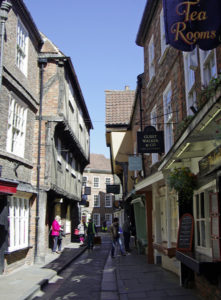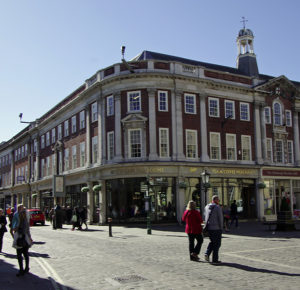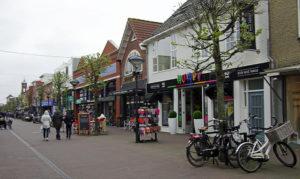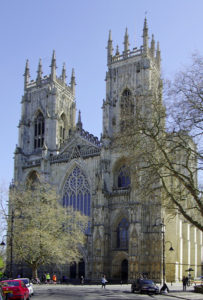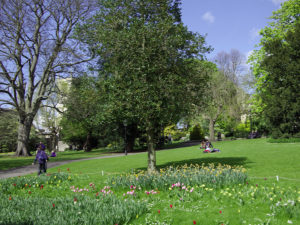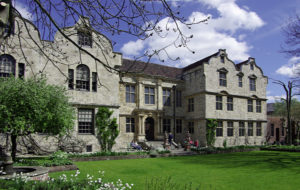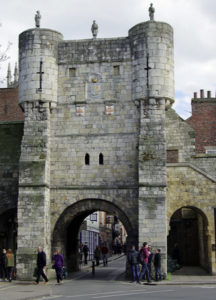When Silver Travel Advisor emailed saying “We would like to book you and Michael a special treat of an overnight stay in a nice hotel”, it didn’t take long to decide on York and the “Dean Court Hotel.”:http://www.silvertraveladvisor.com/blog/boutique-country-house-spa-and-luxury-hotels/dean-court-hotel-york
It is years since we’ve wandered round York, The last few visits have been to the national Railway Museum with train mad grandsons. I had forgotten just how nice York was.
We spent the two days in the historic centre of York, the medieval walled city still with its narrow paved streets and overhanging houses. Traffic controls have succeeded in keeping the centre of York virtually traffic free, pedestrians spill out onto the paved roads adding to the medieval feel. Everywhere is within easy walking distance and streets like Low Petergate, Stonegate and the Shambles are a pleasure to explore with their timber frame and stone buildings. There is plenty to keep the shopaholics entertained, followed by afternoon tea at Betty’s. For those not wanting to walk there is always the hop on hop off bus. Others prefer to see York from a cruise on the River Ouse.
It is a typical medieval city, dominated by church and castle with the magnificent Minster at one end and Clifford’s Tower on its grassy moat at the other. There isn’t a lot to see inside “Clifford’s Tower.”:http://wasleys.org.uk/eleanor/castles/england/york/index.html This is one to admire from the outside. The pale stone of “York Minster”:http://wasleys.org.uk/eleanor/churches/england/yorkshire/north_yorkshire/york/york_1/minster/index.html glows in the sunshine and is one of the largest and perhaps most splendid Gothic buildings in Northern Europe. We just admired the outside this visit. When we visited in April 2015, the east end was covered with scaffolding, part of a multimillion pound conservation and restoration project.
Many medieval churches survive in the historic centre including the delightful “Holy Trinity Church”:http://wasleys.org.uk/eleanor/churches/england/yorkshire/north_yorkshire/york/york_1/holy_trinity/index.html tucked away behind Goodramgate, still with its C17th box pews gently subsiding into the nave. “St Martin’s Church”:http://wasleys.org.uk/eleanor/churches/england/yorkshire/north_yorkshire/york/york_1/st_martin/index.html on Coney Street has risen from the ashes, having been destroyed by bombing in the Second World War. The south aisle has been restored as a small church and is a successful meld of C15th and modern architecture. Fortunately, the C15th stained glass west window was removed for safety before the war and has now been re-erected at the back of the church. “St Sampson’s Church”:http://wasleys.org.uk/eleanor/churches/england/yorkshire/north_yorkshire/york/york_2/st_sampson/index.html on Church Street is no longer used as a church and is now a social centre for the over 60s. This is the place to head for a cup of tea and a chat.
Completely different is the “Bar Convent”:http://wasleys.org.uk/eleanor/churches/england/yorkshire/north_yorkshire/york/york_1/bar_convent/index.html on Blossom Street, the oldest surviving Roman Catholic Convent in England and has a small museum covering the history of the convent as well as stories of persecution and martyrdom during the reformation.
York has a long history, stretching back to the Romans who established a major walled town here. Part of the walls and one of the “Roman towers”:http://www.silvertraveladvisor.com/review/attraction/156639-review-the-multangular-tower-and-the-roman-york can still be seen in the Museum Gardens. The remains of the Basilica survive in the Minster Undercroft. Perhaps one of the most intriguing Roman legacy is the story of the ghosts of a defeated Roman Army seen in the cellars of the Treasurer’s House.
The Vikings sacked York, covered the Roman defences and established a major Viking settlement in the area of Coppergate in the late C9th. When “Jorvik”:http://jorvik-viking-centre.co.uk/ opened in 1984, it was the first of its kind, travelling back in time to the sights, sounds and smells of Viking York. Now the novelty has worn off and the queues have gone. York Viking Festival is celebrated every February.
There is more history in the “Yorkshire Museum”:http://www.yorkshiremuseum.org.uk/ in the Museum Gardens with exhibits on archaeology and geology as well as the history of York from Roman to Medieval times.
The “Castle Museum”:http://www.silvertraveladvisor.com/travel-product/attraction-museum/140836 is a fascinating visit covering the social history of York with reconstructions of a Victorian street with shops. This was one of the first museums to adopt this approach and is still one of the best. The C18th prison buildings look at prison conditions including the cell where Dick Turpin spent his last night.
Bringing the story more up to date is the “Cold War Bunker “:http://www.english-heritage.org.uk/visit/places/york-cold-war-bunker which gives visitors chance to enter the two storey underground bunker built in the 1960s in preparation for a nuclear war. It is the only one preserved in operational condition and would have acted as a nerve centre and monitoring nuclear fallout.
“The National Railway Museum”:http://www.silvertraveladvisor.com/travel-product/attraction-museum/137897 is a perennial favourite with the kids and tells the story of rail transport in Britain. It is the home of iconic steam locos such as Mallard, City of Truro, Flying Scotsman and the Green Arrow. It also has a display of Royal coaches as well as a travelling post office.
York used to be renowned for making chocolate with Both Terrys and Rowntree based here. Now the chocolate is made elsewhere. “The Chocolate Story”:http://www.silvertraveladvisor.com/review/attraction/155487-review-yorks-chocolate-story is a popular visitor attraction telling the story of chocolate in York, with a chance to make your own chocolate.
Beer however is still made in the city and a guided tour of the “York Brewery Centre”:http://www.york-brewery.co.uk/ explains how the different beers are made with a chance to sample the different beers.
For those prefering the stately home experience, the “Treasurer’s House”:http://wasleys.org.uk/eleanor/stately_homes_castles/england/north/treasurers_house/index.html tucked away behind the Minster was lovingly restored by the wealthy C19th industrialist Frank Green to hold his collection of furniture and pictures. The gardens are free to enter when the house is open and are a haven of peace and quiet away from the tourist bustle of York.
“Fairfax House”:http://www.fairfaxhouse.co.uk/ is an example of luxury living in the C18th. The immaculately restored “Barley Hall,”:http://barleyhall.co.uk/ once the home of the Mayor of York, is a medieval experience with costumed interpreters. The timber frame “Merchant Venturers’ Hall”:http://www.theyorkcompany.co.uk/ dates from the C14th and is where the wealthy York merchants gathered to do business. It has one of the best timber frame roofs in northern England.
York’s history also had its dark side. “York Dungeon”:http://www.thedungeons.com/york/en/ is not for the faint hearted being an interactive experience with a cast of actors and special effects. For those wanting to explore the seamier side of York, there are also nightly ghost walks.
The walls make a lovely walk in the sunshine and the “Museum Gardens”:http://wasleys.org.uk/eleanor/gardens/england/north/museum_york/index.html just outside the walls, with the ruins of St Mary’s Abbey are a lovely place to drop out on a warm summer’s day. York really has the lot.
